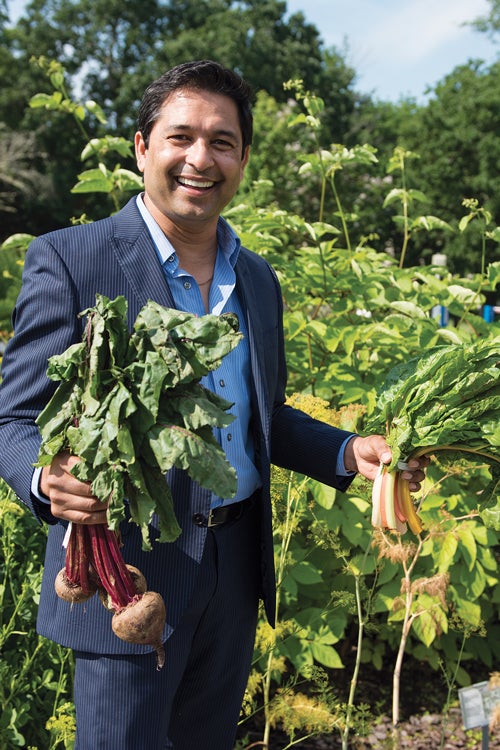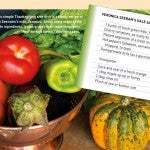Sage Advice
 The latest research bears out an old adage: Eat your colors. A biomedical pharmacy star gives us the lowdown.
The latest research bears out an old adage: Eat your colors. A biomedical pharmacy star gives us the lowdown.
In a world gone crazy with supplements and nutritional advice, one URI pharmacy professor can give you cutting-edge advice—and it sounds just like something your grandma would say. As harvest time begins, make your meals as colorful as the vibrant reds, oranges and yellows of the New England countryside.
 Navindra Seeram, associate professor of biomedical and pharmaceutical sciences in the College of Pharmacy, knows that the brighter your food, the better your diet. And he should know; head of the Bioactive Botanical Research Laboratory, he also oversees the Heber Youngken Jr. Medicinal Garden at the College of Pharmacy, where native thyme and mallow rub shoulders with imports like ginkgo and coffee, and small plaques tell browsers what properties the plants have. It’s a treasure trove of folklore, much of it borne out by research: we all know poppies are an analgesic, for instance, but did you know peonies regulate cardiac action?
Navindra Seeram, associate professor of biomedical and pharmaceutical sciences in the College of Pharmacy, knows that the brighter your food, the better your diet. And he should know; head of the Bioactive Botanical Research Laboratory, he also oversees the Heber Youngken Jr. Medicinal Garden at the College of Pharmacy, where native thyme and mallow rub shoulders with imports like ginkgo and coffee, and small plaques tell browsers what properties the plants have. It’s a treasure trove of folklore, much of it borne out by research: we all know poppies are an analgesic, for instance, but did you know peonies regulate cardiac action?
Seeram has spent his career analyzing what he calls “nature’s pharmacy,” examining plants native to here and the Caribbean, and his research has created ripples far beyond Kingston. It’s in large part thanks to his team, for instance, that we now know just which antioxidants make blueberries so good for us. His work on maple syrup garnered headlines last year when it isolated 52 distinct beneficial compounds, including one with anti-diabetic properties.
Antioxidants, he says, arose because they are part of a plant’s defense strategy; they protect it against a lifetime of exposure to the sun. They do similar things for us.
“There is a reason why humans see color,” he explains. “We co-evolved with plants, and that evolution was beneficial for both. Humans had a healthy and easily obtainable food source that was attractive to the eye. Through the consumption and digestion of fruits and vegetables, humans helped distribute the seeds of the plants.”
Go back 50,000 years, he adds, and the human diet was almost all fruits, nuts, grains, and vegetables. Now, what’s on the supermarket shelves mimics that natural bounty in appearance only. “Instead of eating foods rich in natural colors and nutrients,” Seeram points out, “we have chosen processed foods in bright, colorful packages.”
The result? “Obesity is an epidemic in this country, especially among children.”
 But we only need take lessons from the world around us. For instance, as birds prepare for their migrations south, they’ll soon load up on native berries on Block Island, an important last landfall along the Atlantic Flyway. Seeram and colleague Scott McWilliams, professor of ecology and wildlife biology, believe birds choose certain berries because they offer protections against the oxidative stress that occurs during long flights. They’re currently studying which berries various species eat, and why.
But we only need take lessons from the world around us. For instance, as birds prepare for their migrations south, they’ll soon load up on native berries on Block Island, an important last landfall along the Atlantic Flyway. Seeram and colleague Scott McWilliams, professor of ecology and wildlife biology, believe birds choose certain berries because they offer protections against the oxidative stress that occurs during long flights. They’re currently studying which berries various species eat, and why.
So with fall tailgating and the feasts and parties of the holiday season ahead of us, Seeram urges us to get back to basics: “On your harvest plate, if there isn’t plenty of color, there is something wrong.”
— Dave Lavallee
 Home
Home Browse
Browse Close
Close Events
Events Maps
Maps Email
Email Brightspace
Brightspace eCampus
eCampus


